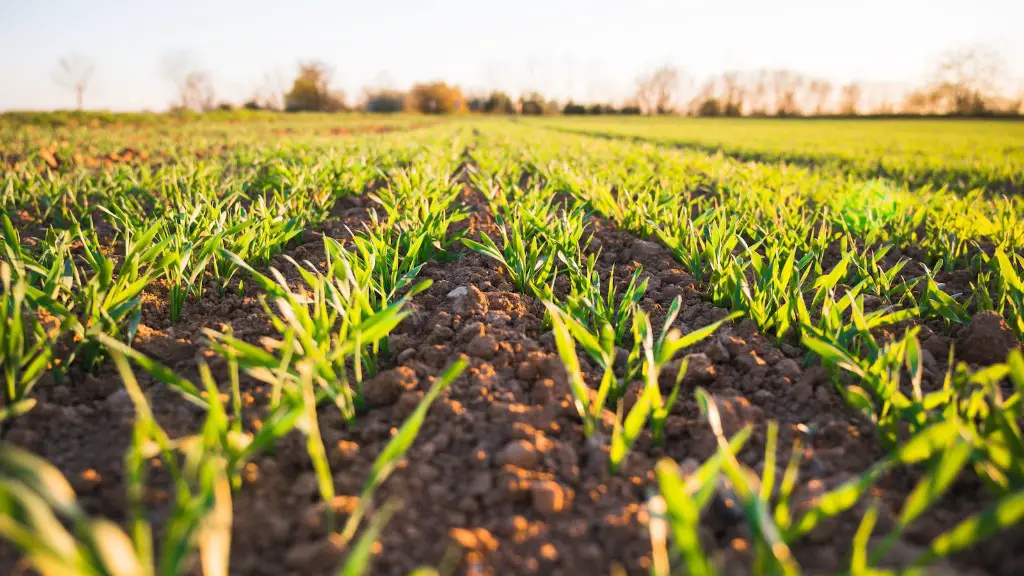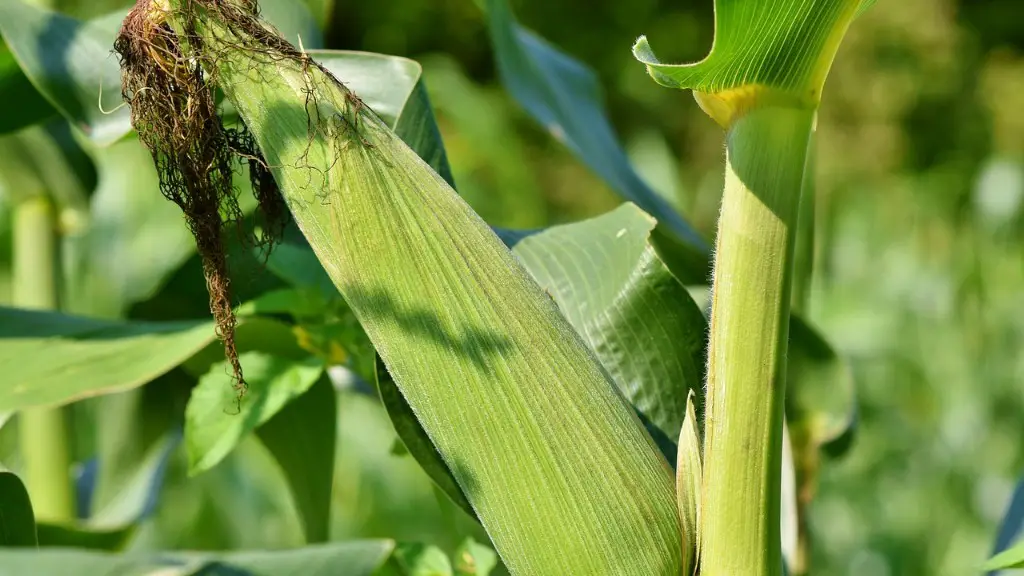Mottled soil in agriculture is a form of wetland soil that is highly clay-rich and often bears a distinctive pattern of white or grayish spots or patches. The mottling is caused by local changes in the soil’s water-holding capacity and oxygen levels, which in turn affects the growth of the plants rooted there. While not desirable for all crops, mottled soil is known for having greater water-holding capacity and nutrient availability which makes it beneficial for certain crops and farming practices.
The mottling effect is caused by a combination of soil’s characteristics. In mottled soil, water infiltrates the ground at different rates resulting in a mismatch of oxygen levels, which can give the soil its mottled appearance. The depth at which the mottling occurs represents where an interface between high air porosity and lower water porosity exists in the soil.
Mottling can be beneficial for certain crops, as it provides increased nutrients and water retention which can increase yields. Because in general mottled soils have higher clay content, they have better water-holding capacity, which can help crops survive in areas prone to drought. Furthermore, with higher temperature soil moisture rarely exceeds field capacity, meaning crops can more easily access water they require.
In addition to helping crops withstand drought, mottled soil is naturally high in fertility and can provide productive yields without the need for additional fertilizers. The mottling creates increased opportunities for microbial activity, which further leads to increased nutrient availability for plants and improved soil structure.
Despite the benefits, mottled soil can cause problems for certain farming practices, such as flooding which can occur when water infiltrates the soil and creats shallow, local saturation. Other management concerns arise from high clay contents of mottled soils, as they can be tough to work with and require higher inputs of energy to till, tillage operations can cause compaction and can decrease fertility of the soil.
Overall, mottled soil in agriculture is a soil type that has mixed benefits and challenges. While it can be beneficial due to its water-holding capacity and increased fertility, it can also be tricky to work with and have increased susceptibility to flooding. When managed correctly, however, mottled soils can be useful in balancing water-stressed climates, allowing greater production and yield.
What causes mottling effect in soil?
The mottling effect in soil is caused by a combination of its characteristics that result in a mismatch of oxygen levels. Generally, mottled soils have higher clay content which means that water infiltrates the ground at different rates and leads to unequal oxygen levels. This unequal oxygen availability gives rise to the distinctive pattern of white and grayish spots or patches in the soil.
Depth at which the mottling occurs is determined by where an interface between higher air porosity and lower water porosity exists in the soil. Because of this difference in oxygen levels, mottled soils can have benefits for certain crops because they can provide increased water-holding capacity and nutrient availability, allowing them to better withstand drought.
High clay content is not always desirable, however, as these soils can be tough to work with and require higher inputs of energy to till. Furthermore, the increase in water infiltration can lead to local flooding which can damage crops and equipment. Understanding the depth and patterns of mottled soil is essential in order to properly manage it and take advantage of its benefits.
The mottling effect in soil is not only caused by its clay content, however. In specific conditions, the presence of calcium, iron, or aluminum can have an effect on the appearance and physical characteristics of the soil. In certain cases, these elements can lead to reduced fertility or water infiltration in certain parts of the soil.
Taken together, it’s important to consider the combination of soil’s characteristics when producing mottled soil. Too much clay content can be tough to work with, too much calcium can reduce fertility, and incorrect water infiltration can lead to flooding. Proper management with these things taken into account is essential in order to fully reap the benefits of mottled soils.
How can mottled soil be beneficial in agriculture?
Mottled soils can be beneficial for certain crops and farming practices due to their higher water-holding capacity, nutrient availability, and natural fertility. This can be especially helpful in areas prone to drought, as the soil can better retain moisture and provide moisture to plants. Furthermore, in general mottled soils can reduce the need for additional fertilizers due to their higher levels of nutrients.
The microbial activity in mottled soils is a major part of its benefits, as increased microbial activity can further lead to increased nutrient availability for plants and improved soil structure. This can result in increased production and yield with less effort, allowing more efficient and productive farming practices.
The increased water-storing capacity of mottled soils can come in handy in more temperate climates as well. Thus, crops can more easily access the water they require while never exceeding field capacity. This makes mottled soils useful in balancing water-stressed climates, allowing greater production and yield.
In addition, mottled soils can have increased drainage and infiltration, allowing improved soil quality and avoiding waterlogging in continuous rains. This can help keep the soil more oxygenated and more productive, reducing the risk of crop failure and decreasing the need for additional inputs.
In a nutshell, mottled soils can be extremely beneficial for certain crops and farming practices. They can provide increased water retention, nutrient availability, and increased production and yields for crops. They also can help to better balance water-stressed climates, increase soil quality, and reduce the need for additional inputs, among other benefits.
What are the challenges of managing mottled soil?
While mottled soils can be beneficial for certain crops, they also include their own challenges. Mainly, the challenge lies in proper management to take advantage of its benefits and limit potential problems. Generally, the high clay content of mottled soils can be difficult to work with and require higher inputs of energy to till. When done incorrectly, this can cause compaction of the soil and decrease its fertility.
Furthermore, if overly saturated, mottled soils can be prone to surface runoff which can cause loss of topsoil and lead to erosion. Additionally, these soils can increase the risk of local flooding which can damage crops, soil structure, and can destroy equipment that isn’t properly protected.
In certain cases, mottled soil can contain elements such as calcium, iron or aluminum, which can have an effect on the soil’s fertility and water infiltration. In some cases, these nutrients can be beneficial and increase fertility of the soil, however, high levels can also reduce fertility or lead to water infiltration into wrong parts of the property, leading to crop failure and flooding.
In summary, mottled soils are in general beneficial for certain crops, however successful management of these soils is essential for taking advantage of the full benefits. In order to successfully manage mottled soils, the soil composition needs to be taken into account, water infiltration should be monitored, and soil compaction should be avoided.
How can mottled soil be improved?
Mottled soil can be improved and managed by taking steps to better control its water infiltration, clay content, and fertility. Generally, to improve water infiltration, soil amendments should be added to the soil. These could be organic matter, crumbled organic compost, or gypsum, among other possibilities.
In order to reduce compaction, tillage operations should be minimized, and soil amendments should be added to enrich the soil and make it better able to store and retain water. Organic matter can also help reduce compaction and is also beneficial for fertility.
After taking these steps to better control the soil’s water infiltration and compaction, nutrient levels can then be monitored and soil testing can be used to better understand the soil’s fertility levels. If necessary, fertilizer can then be added, or soil amendments such as compost and manure can be added to enhance fertility.
When taken together, these steps, if done correctly, can significantly improve mottled soil and take full advantage of its benefits. It allows for better control of water infiltration and soil compaction, as well as better understanding and control of fertility, so that crops can grow to their full potential.
What types of crops are mottled soils suitable for?
Mottled soils are generally suitable for certain types of salt-tolerant, water-loving, or drought-tolerant crops as they provide greater water-holding capacity and improved nutrient availability. Examples of these types of crops include rice, cotton, apples, and potatoes, among others.
Similarly, mottled soils are often used for pastureland and are ideal for beef and dairy cattle, horses, sheep, goats, llamas, and alpacas, among others. Crops grown in mottled soils can benefit from increased water-holding capacity, improved nutrient availability, and increased fertility. This can have a significant positive impact on production and yields.
In general, mottled soils are suited for crops and animals which can more easily access the water they require and which are not susceptible to flooding. Furthermore, high clay contents of mottled soil increase water-holding capacity, allowing crops to better withstand drought. Lastly, mottled soil is praised for its nutrient availability, allowing for higher natural fertility and less need for additional fertilizers.
All in all, mottled soil provides great benefits for many types of crops, including water-loving, drought-tolerant crops, and pastureland plants. Proper management and water infiltration control is essential to maximize the benefits of this soil type and properly take care of crops and animals.





